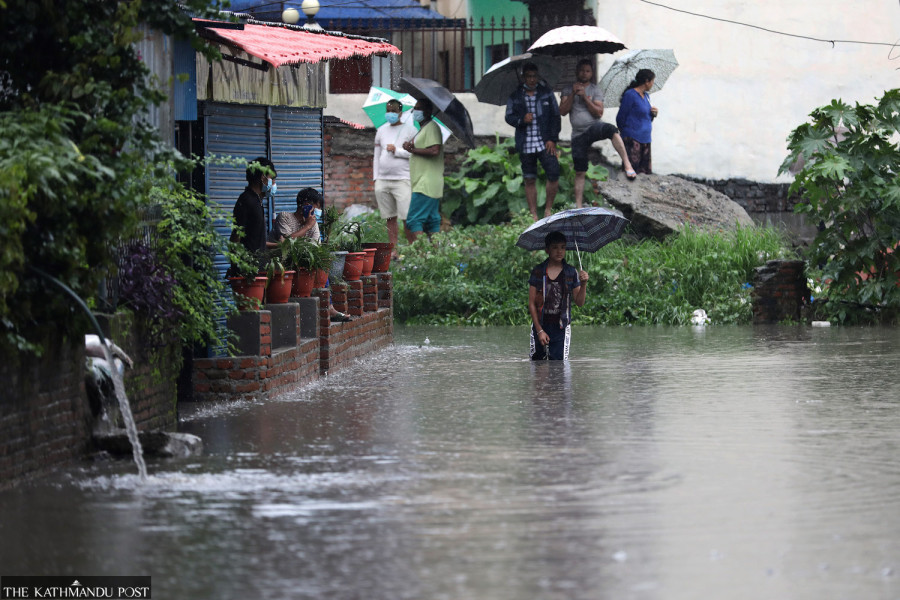Columns
Our new normal of vacillating monsoons
Unless we enhance our capacity to manage water at the local level, we’re bound to suffer.
Madhukar Upadhya
This year’s monsoon arrived on June 11, three days earlier than the usual onset date, bringing rain to the eastern parts of Nepal. However, it didn’t move to the rest of the country, which was reeling under a heat wave with temperatures reaching as high as 44 degrees Celsius for weeks. Most initial rainfall predictions failed, and the monsoon that reached the central parts two weeks later was heavy and destructive.
In the early hours of June 26, a mudslide in Lamjung district damaged three houses and killed four people—a 67-year-old man, his daughter-in-law and her two young daughters. By July 6, the monsoon was active throughout the country, causing widespread damage to roads and settlements. Landslides reported in 157 places disrupted vehicular movement on most hill roads. The death toll due to landslides alone reached 53, with 19 others killed by floods. On July 12, debris flow on the Muglin-Narayangarh road pushed two buses into the Trishuli River; of the total 65 passengers in the two buses, three were found alive, five found dead and the rest are missing.
These early events illustrate the erratic and unreliable nature of monsoons, as has been expected due to a warmer climate. They are also a cause for concern as these emerging trends have affected our economy and livelihoods and led to increased disaster events. Most of these disasters, like the one in Lamjung, could have been prevented with aptly developed stormwater management strategies that our disaster preparedness initiatives have consistently ignored.
The changes
The monsoon is gradually changing its intensity, rainfall patterns and timing. On July 8, around 624 mm of rain was measured over a single day in Dodhara of Kanchanpur district. It replaced the 1993 record of 540 mm in 24 hours recorded in Kulekhani. The rainfall events are often localised and dominated by high-intensity, short-duration rain. Even then, when one area gets heavy rain, the adjoining area may remain dry. Such an anomaly is more pronounced in mountainous terrain due to its orographic effects. The conventional rainfall forecast does not capture such variance nor does the data from existing meteorological stations provide adequate and real-time information for analysis and planning.
The rainfall pattern has also changed. In a country-wide survey conducted by the National Statistics Office in 2022, about 90 percent of respondents across all geographical regions observed changes in the rainfall pattern between June and September—a similar percent of respondents also saw differences in the rainfall pattern during winter.
The monsoon is also shifting northward, bringing rain in areas at higher altitudes like Manang and Mustang districts, which normally get either snow or remain dry during the monsoon. Similar studies conducted in Pakistan to assess such a shift indicated that the monsoons there have also moved northward. The study also stated another worrying concern: This shift has made the southern areas, which previously received normal rain, drier as they get less rain now. A similar trend was also observed in India, where some areas in the Gangetic plains have received less rain. However, areas that were arid in the past, particularly in the western part of the country, have started to receive more rain, causing aberrant floods.
Required strategy
Local water sources are crucial for most economic activities, particularly farming and sustaining rivulets and khola. The general understanding of the importance of local water issues has grown in the last decade: How haphazard road construction has increased landslides in the hills, how sealing of surfaces in the plains and drainage congestions have led to a growing scourge of urban flooding or how encroachment in the river banks has compounded flood damage.
However, the corrective action required remains very slow compared to the changing pace of rainfall patterns. Instead of considering these budding nuances, our approach to both development in general and infrastructure in particular has consistently ignored them—a cost we are bound to bear in the years ahead. The drainage structures rebuilt to accommodate runoff on the major roads in the capital in the last five years have been proven inadequate to drain rainwater during heavy rains.
The conventional agriculture rhythm no longer matches this changing context. The shift is inconveniencing those who have adapted their farming and other economic activities to the usual timing and levels of rain/snow. The rice saplings prepared for plantation in the second half of June, for example, matured and became less productive when the rains arrived late for transplantation. Those who planted the right-age saplings on time by pumping water also lost crops when the rain came late due to a dry spell in between. To avoid this threat to our food security and farmers’ economic prospects, it’s time we matched the agricultural rhythm to the changing monsoonal pattern.
Engaging the youth
Changes in the monsoon are likely to be more pronounced in the years ahead. Unless we enhance our capacity to manage water at the local level, we’re bound to suffer. Hydrological analysis in this altered context requires substantial decentralised data because rainfall’s localised nature often becomes runoff and fails to enter the subsurface to replenish soil moisture and aquifers.
In this regard, an example of a community-driven initiative started by the state government of Kerala, India, is worth considering. To generate rainfall data that was as decentralised as possible, they have installed well-equipped weather stations in over 270 government schools in the state and trained students to record changes in rain and temperature to help them understand rainfall anomalies and adopt necessary measures for water management.
Kerala’s community-driven initiative to engage, train and empower the decision-makers of tomorrow is an excellent way of ensuring a deeper appreciation of changing rainfall patterns across geographical zones and helping build appropriate strategies to meet local needs. Assisting schools in installing weather stations to monitor rainfall and recognising local water issues will provide future decision-makers with an encompassing awareness of the evolving nature of monsoons and formulate strategies, including affordable and actionable tactics to manage water at the local level.
Youth engagement can be further reinforced by introducing practical classes as part of the curriculum on building water harvesting structures, such as small ponds, and monitoring their progress periodically while they’re in school. This will help them gain invaluable knowledge about rainfall, local hydrology and understanding how managing rainwater is, in fact, crucial to sustaining our lives and our environment in a warmer world.




 29.12°C Kathmandu
29.12°C Kathmandu















